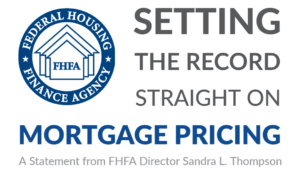UPDATE (5/10/2023)
This afternoon, the Federal Housing Finance Agency (FHFA) rescinded its proposed LLPA fee based upon a borrower’s debt-to-income (DTI) ratio which was slated to become effective in August 2023. Read more about the cancellation here.
Recently, the Federal Housing Finance Agency (FHFA) announced changes to the pricing framework for Fannie Mae and Freddie Mac loans.
“These changes to upfront fees will strengthen the safety and soundness of the Enterprises by enhancing their ability to improve their capital position over time,” said Director Sandra L. Thompson. “By locking in the upfront fee eliminations announced last October, FHFA is taking another step to ensure that the Enterprises advance their mission of facilitating equitable and sustainable access to homeownership.”

The changes include two pillars:
- Effective May 1, 2023 — Lenders will be required to charge upfront fees to borrowers based on their credit score.
- Effective August 1, 2023 — A new debt-to-income (DTI) ratio fee structure will be imposed on borrowers whose DTI is greater than 40 percent (These changes were rescinded on May 10, 2023 after significant urging from The National Association of REALTORS®. Read more here).
Fannie May released a loan level pricing adjustment (LLPA) matrix to show the new setup.
Debates from the announcement incited FHFA Director Sandra L. Thompson to release a statement, ironing out some of the misconceptions around the new structure. Below are the key discussions addressed directly by Thompson:
- Higher-credit-score borrowers are not being charged more so that lower-credit-score borrowers can pay less. The updated fees, as was true of the prior fees, generally increase as credit scores decrease for any given level of down payment.
- Some updated fees are higher and some are lower, in differing amounts. They do not represent pure decreases for high-risk borrowers or pure increases for low-risk borrowers. Many borrowers with high credit scores or large down payments will see their fees decrease or remain flat.
- Some mistakenly assume that the prior pricing framework was somehow perfectly calibrated to risk – despite many years passing since that framework was reviewed comprehensively. The fees associated with a borrower’s credit score and down payment will now be better aligned with the expected long-term financial performance of those mortgages relative to their risks.
- The new framework does not provide incentives for a borrower to make a lower down payment to benefit from lower fees. Borrowers making a down payment smaller than 20 percent of the home’s value typically pay mortgage insurance premiums, so these must be added to the fees charged by the Enterprises when considering a borrower’s total costs.
- The targeted eliminations of upfront fees for borrowers with lower incomes – not lower credit scores – primarily are supported by the higher fees on products such as second homes and cash-out refinances. The Enterprises’ statutory charters specifically include references to supporting low- and moderate-income families by earning returns on mortgages for these borrowers that may be less than the returns earned on other products. Indeed, Congress incorporated this into the Enterprises’ charters decades ago and it is a long-standing component of the Enterprises’ core business models.
- The changes to the pricing framework were not designed to stimulate mortgage demand. We publicly announced the objectives of the pricing review at its onset (as noted above), and stimulating demand was never a goal of our work.
We will continue to monitor developments around the new structure so we can best educate members moving forward.






1 Comment